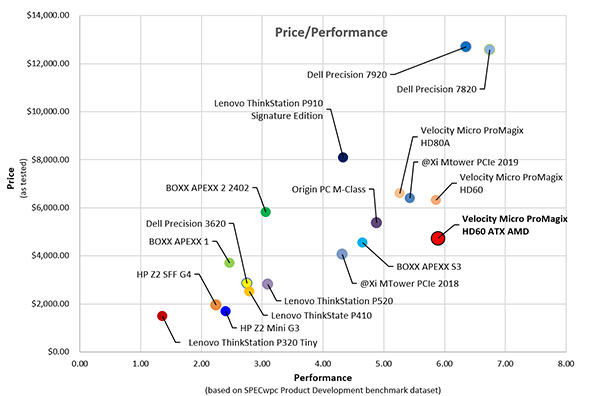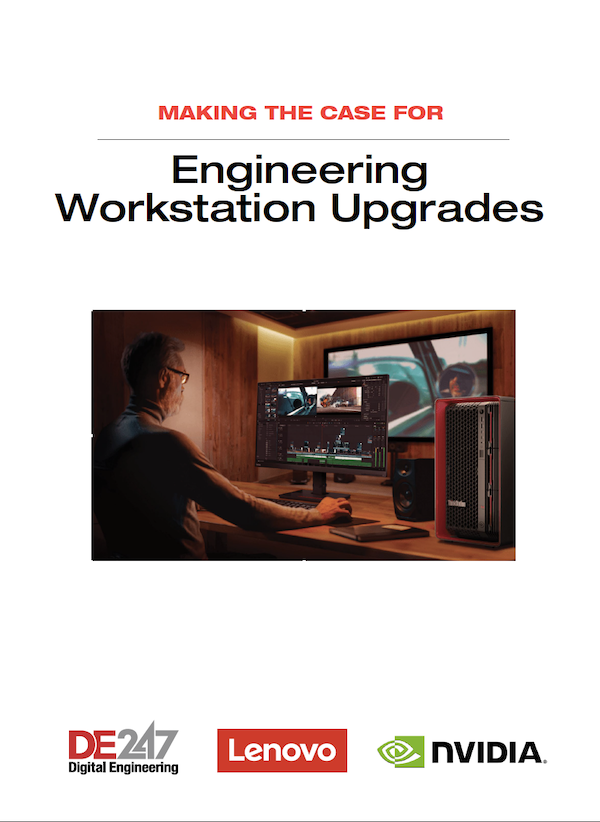Performance without Breaking the Bank: Velocity Micro ProMagix HD60 ATX AMD Review
This system integrator delivers a price/performance winner.

Image courtesy of Velocity Micro.
Latest News
April 5, 2020
We recently received a new tower workstation from Velocity Micro, the third system the Richmond, VA-based system integrator has sent us in the past year-and-a-half. Although similar in appearance and name to the computer we reviewed earlier this year (DE, August 2019), the ProMagix HD60 ATX AMD is based on an AMD Ryzen CPU, as was the first system the company sent us last year (DE, July 2018). This marks only the second AMD Ryzen-based system we have looked at since that CPU was first release in March of 2017, and the first to use the new 7nm Ryzen 9 processor.
In other words, if you purchased the parts and built it yourself, you could save around $1,200 (compared to the as-tested price, minus the 3-year warranty). Of course, that assumes you have the requisite skill, confidence, and time to do it yourself. Buying a system assembled by trained technicians and backed by a warranty from a reputable company is likely worth the 28% markup when it comes with the peace of mind of knowing that the system is guaranteed to work when it arrives.
The Velocity Micro ProMagix HD60 ATX AMD workstation comes housed in a large charcoal gray tower case measuring 7.25-in. x 21.0-in. x 20.0-in. (WxDxH) and weighing 26.75 lbs. The monolithic front features an optical drive bay near the top and a Velocity Micro logo cutout near the bottom. The power button, a pair of USB 3.1 ports, plus microphone and headphone jacks are located on the top of the case, set several inches back from the front edge. A pair of cooling fans are also visible below vents on the top of the case and both the fans and front panel logo glow blue when the system is powered up. Like the other ProMagix HD60 we reviewed in August, the system ran quiet, averaging less than 50dB at rest and climbing to just 64dB under heavy compute loads.
The rear of the case provides a total of 12 USB ports—four USB 3.2 Gen 1 ports, seven USB 3.2 Gen 2 Type-A ports, and one USB 3.2 Gen 2 Type-C port—as well a pair of RJ-45 ports for the integrated Intel gigabit LAN, antenna connectors for the build-in WiFi, an S/PDIF port, and five audio jacks (microphone, line-out/front speaker, line-in/side speaker, rear speaker, and center/sub-woofer). There are also CMOS Clear and USB BIOS Flashback buttons. The thin left‑side panel, with a large window etched with the Velocity Micro name and logo, is held in place with ten snap connectors. Once removed, you have complete access to the very well-organized interior with five internal drive bays, one of which was filled.

Lots of Options
Velocity Micro now sells four different versions of the ProMagix HD60—mid-towers or full-towers with either AMD or Intel CPUs. Based on that new nomenclature, the full designation of this system is the ProMagix HD60 ATX AMD, which has a starting price of $1,599. That selection gets you an extended-depth ATX aluminum chassis manufactured by Lian Li, with a power supply mounted at the bottom rear.
The base configuration includes a 750-watt power supply, an Asus X570 motherboard, an AMD Ryzen 5 3600X 6-core 3.8GHz CPU, 8GB of 2666MHz memory, an NVIDIA Quadro P400 GPU, a 250GB M.2 SSD, and a 24X DVD+/-RW dual-layer optical drive, plus a copy of Windows 10 Home, all backed by a 1-year warranty. But as we have come to expect from Velocity Micro, that is just the starting point. There are lots of configuration options available on the Velocity Micro website.
For example, the company offers a choice of six different power supplies, ranging from 650 to 1600-watts. The system we received came with an 850-watt EVGA SuperNOVA 80Plus Gold certified power supply, which added $100. You also can choose from among five different motherboards. Our evaluation unit was built around the top-of-the-line offering, an Asus Crosshair Hero VIII motherboard, a $285 option, that provides four DIMM sockets, supporting a maximum of 128GB of non-ECC unbuffered memory. Our system came with 32GB, installed using two 16GB Crucial Ballistix DDR4-3200MHz memory modules, which added $155 to the price. That motherboard also provides three PCIe 3.0 x16 slots and a single PCIe x1 slot. An Intel wireless AX2000 adapter, which supports 802.11 a/b/g/n/ac/ax plus Bluetooth 5.0, is also integrated into the motherboard.
The motherboard also supports a wide range of AMD Ryzen processors, and Velocity Micro offers a choice of five CPUs. The system we received contained a 3.5GHz AMD Ryzen 9 3950X processor, a 16-core CPU with a 4.7GHz maximum turbo boost frequency and a 64MB L3 cache. While the base configuration includes just a simple heat sink, Velocity Micro offers four additional cooling options. Our evaluation unit came with a closed-loop liquid cooling system with a pair of blue lighted fans, a $130 option, as well as using IC Diamond thermal interface material, adding $25 more.
Since the new Ryzen CPU does not include integrated video, Velocity Micro offers a choice of 22 different video cards, ranging from NVIDIA GeForce gaming cards to high-end NVIDIA workstation-class GPUs. Our evaluation unit included an NVIDIA Quadro RTX 4000 GPU ($930). This board provides 2,304 CUDA cores,288 Tensor cores, and 36 RT cores and 8GB of dedicated GDDR6 memory. With a 256-bit interface, the board can deliver a memory bandwidth of up to 416 GB/second, enabling it to achieve 7.1 trillion single-precision floating point operations per second and to perform real-time ray tracing. The RTX 4000 provides three DisplayPort 1.4 connectors and one VirtualLink connector and can support four displays at up to 3840x2160 resolution at 120Hz, four displays at 5120x2880 resolution at 60Hz, or two displays at 7680x4320 at 60Hz.
The system also supports a massive amount of storage, with multiple M.2 slots and support for up to eight SATA drives. While the base ProMagix configuration comes with a 256GB SSD, Velocity Micro offers solid state drives of up to 2TB and SATA drives up to 8TB capacity. Our evaluation unit included a 1TB Gigabyte Aorus PCIe 4th generation NVMe M.2 drive (a $270 option) as well as a 2TB 7200rpm SATA 600 HD drive with a 64MB cache (adding another $85). A 24X DVD+/-RW dual-layer drive is standard, or you can opt for a 16X Blu-ray burner.
Stellar Performance
With its powerful CPU and GPU, we expected excellent performance from this Velocity Micro workstation, but were still surprised by the results we recorded on our tests. On the SPECviewperf benchmark, which focuses on graphic performance, the ProMagix HD60 ATX AMD turned in great results. The only systems that surpassed its performance were those equipped with even more powerful (and more expensive) RTX GPUs. On the SPECapc SolidWorks benchmark, the Velocity Micro system also performed well.
On the very demanding SPECwpc workstation performance benchmark, the performance was nothing short of amazing, earning top scores on many individual tests and turning in results that were only surpassed by systems equipped with over-clocked CPUs with many more processor cores. Its CPU and storage subsystem scores were the highest we’ve ever recorded. And on our own AutoCAD rendering test, the 23.9 second average time was just 0.1 second behind the fastest system we have ever tested.
While the base configuration includes Windows 10 Home, Windows 10 Professional came pre-installed on our system, adding $70. Alternatively, you can save $80 by ordering the system without an OS and install your own. Velocity Micro does not include a mouse or keyboard unless you specifically add one to your order. We included a basic Microsoft USB keyboard ($20) and optical mouse ($15) in our as-tested price.
The standard Velocity Micro warranty only covers the system for one year. Since many OEMs warrant their workstations for three years, our as-tested price includes a $399 charge to extend coverage to three years for parts, labor, and depot repair service. Velocity Micro also includes a lifetime upgrade plan that allows you to return your system for maintenance, upgrades, and testing.
As configured, our system priced out at $4,733, making it a clear price/performance winner—the fastest system we have ever tested for under $5,000. Although equipped with certified hardware, the system itself lacks ISV certification. It that is not an issue for you, Velocity Micro has again proven that it knows how to assemble high-end workstations. Quite simply, this latest Velocity Micro HD60 workstation is a winner.
Subscribe to our FREE magazine, FREE email newsletters or both!
Latest News
About the Author
David Cohn is a consultant and technical writer based in Bellingham, WA, and has been benchmarking PCs since 1984. He is a Contributing Editor to Digital Engineering, the former senior content manager at 4D Technologies, and the author of more than a dozen books. Email at [email protected] or visit his website at www.dscohn.com.
Follow DERelated Topics






